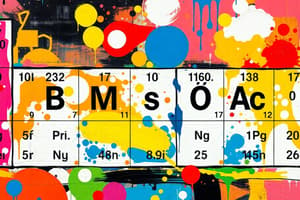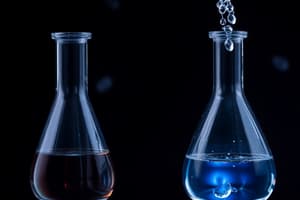Podcast
Questions and Answers
What is the primary subject of the provided text?
What is the primary subject of the provided text?
- An overview of different camera models
- Instructions for operating a scanner
- The name of a mobile application (correct)
- A history of scanning technology
Based on the text, CamScanner is a type of hardware.
Based on the text, CamScanner is a type of hardware.
False (B)
What is the most likely purpose of the item named in the text?
What is the most likely purpose of the item named in the text?
Scanning documents
The text repeatedly shows the word ______, which is a mobile application.
The text repeatedly shows the word ______, which is a mobile application.
Match the following application name with its function:
Match the following application name with its function:
What is CamScanner primarily used for?
What is CamScanner primarily used for?
CamScanner is a type of hardware device.
CamScanner is a type of hardware device.
What functionality does CamScanner provide to its users?
What functionality does CamScanner provide to its users?
CamScanner is commonly used for ________ documents.
CamScanner is commonly used for ________ documents.
Match the following features with their descriptions related to CamScanner:
Match the following features with their descriptions related to CamScanner:
Flashcards
What is CamScanner?
What is CamScanner?
CamScanner is a mobile app that allows users to scan documents, receipts, and other paper documents using a smartphone camera and convert them into digital files.
How does CamScanner work?
How does CamScanner work?
CamScanner uses image processing algorithms to enhance the scanned documents, remove background noise, and straighten the edges to create clear and legible digital copies.
How can I share documents scanned with CamScanner?
How can I share documents scanned with CamScanner?
CamScanner allows users to share scanned documents with others via email, cloud storage services, or social media platforms.
Can I save my scans?
Can I save my scans?
Signup and view all the flashcards
Can I edit text from scanned documents?
Can I edit text from scanned documents?
Signup and view all the flashcards
How can I share scans?
How can I share scans?
Signup and view all the flashcards
Can I edit text from scans?
Can I edit text from scans?
Signup and view all the flashcards
Study Notes
Elements, Compounds, and Mixtures
- Elements, compounds, and mixtures are different forms of matter
- Matter occupies space and has mass
- Pure substances are either elements or compounds
- Mixtures contain two or more pure substances
Pure Substances
- Have a definite, fixed composition
- Examples are copper, salt, and sugar
- Show fixed chemical properties
- Consist of one type of atom (elements) or a specific combination of atoms (compounds)
Mixtures
- Made up of two or more pure substances
- Components retain their properties
- No fixed composition
- Can be homogeneous or heterogeneous
- Examples are lemonade, air, milk, and saltwater
Types of Mixtures
- Homogeneous Mixture: Components cannot be distinguished, evenly distributed (e.g. salt solution, sugar syrup)
- Heterogeneous Mixture: Components are distinct and separable (e.g. sand and water, oil and water, milk)
Separation Techniques
- Sieving: This method involves the use of a sieve or mesh screen to separate solids based on their size differences. It is particularly effective in separating particles of various sizes, such as separating fine sand from larger gravel stones. The process relies on the gravitational force that allows smaller particles to pass through the holes of the sieve while larger particles are retained, making it a practical technique in both laboratory settings and industrial applications such as construction and food processing.
- Handpicking: This manual technique involves separating components based on easily observable differences, such as color, size, or shape. Handpicking is commonly used in food processing, for example, when workers remove stones or foreign materials from grains or rice. This method is particularly useful when the components to be separated are distinctly different, allowing for efficient sorting without the need for complex machinery.
- Sedimentation and Decantation: This separation technique is based on the principle of gravity. It allows a solid, often heavier than the liquid, to settle at the bottom of a container over time. Once the solid has settled, the liquid is carefully poured off to separate the two. A common example is the separation of sediment from water in a river or the clarification of muddy water. This method is widely used in various industries, including water treatment and chemical processing.
- Filtration: Filtration is a physical separation method that uses a porous barrier or filter to separate solids from liquids. The filter allows the liquid to pass through while trapping the solid particles. A typical example of this process can be seen in the separation of sand from water, where a filter paper or membrane is used. Filtration is widely employed in laboratories, wastewater treatment, and the production of beverages such as beer and coffee.
- Evaporation: This method is utilized to separate a solid that is dissolved in a liquid by heating the mixture and allowing the liquid to evaporate. As the temperature rises, the liquid transforms into vapor, leaving the solid residue behind. An illustrative example is extracting salt from saltwater; the water evaporates, and salt crystals remain. Evaporation is a common technique in both natural processes, such as the water cycle, and industrial applications, including the production of salt and sugar.
- Magnetic Separation: This technique is invaluable for separating magnetic materials from non-magnetic ones based on their magnetic properties. By applying a magnetic field, magnetic materials like iron filings can be attracted and removed from a mixture, such as separating metal contaminants from sand. This method is commonly employed in the recycling industry, mining operations, and also in food processors to ensure product purity.
- Winnowing: This ancient agricultural method is used to separate lighter components from heavier ones using airflow. In the winnowing process, grains are tossed into the air, and the lighter chaff is blown away while the denser grains fall back down to the ground. It is often used in grain harvesting, where farmers aim to clean the grain and enhance the quality of the yield. This technique can be performed manually or with the assistance of machines.
- Froth Floatation: This sophisticated separation technique is primarily used in the mineral processing industry to separate valuable minerals from their ores based on differences in their hydrophobic properties. During the process, air is injected into a mixture of ground ore and water, creating bubbles that attach to the hydrophobic ore particles. The frothy, buoyant mixture is then drained off, leaving behind impurities. It is commonly employed for extracting metals such as copper, gold, and zinc from their ores.
- Sublimation: Sublimation is a unique process that allows for the separation of substances that change directly from solid to gas without passing through a liquid phase. This method can be effectively utilized to purify substances such as ammonium chloride, where the solid is sublimated and then collected as vapor, which condenses back into a solid form. Sublimation is not only a key phenomenon in physical chemistry but finds applications in various fields, including sublimation printing and food preservation.
- Distillation: Distillation is a widely used separation technique that exploits the difference in boiling points of liquids to separate them. By heating a mixture, the liquid with the lower boiling point vaporizes first, and this vapor is then cooled and condensed back into liquid form, effectively separating it from the rest of the mixture. For instance, in a typical distillation setup, water can be separated from alcohol, allowing for purification or concentration of the desired liquid. This method is fundamental in producing spirits, essential oils, and in petrochemical refining.
- Centrifugation: This technique employs centrifugal force to separate components of a mixture based on their density differences. By spinning a container containing the mixture at high speeds, denser materials move outward to the bottom while lighter materials remain closer to the center. A common application is separating cream from milk, where the fat content is separated efficiently from the liquid. Centrifugation is also essential in laboratories for separating blood components and in various industrial processes.
- Separating Funnel: This apparatus is designed to separate immiscible liquids, which are liquids that do not mix, such as oil and water. A separating funnel is typically a glass or plastic container with a tap at the bottom that allows one liquid to be drained while the other remains in the funnel. This method is frequently used in laboratories and chemical industries to effectively isolate different liquid components for further processing or analysis.
Studying That Suits You
Use AI to generate personalized quizzes and flashcards to suit your learning preferences.





